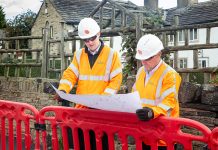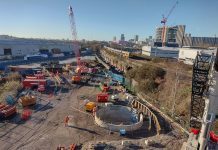Subterra’s Rolldown opens up Thames Water’s Stratford Box
Thames Water Utilities Ltd have recently realised a highly innovative solution for augmenting raw water supplies in East London, in which Subterra’s award-winning Rolldown close-fit PE lining system was chosen to play a key role in its practical implementation on account of Rolldown’s unique characteristics.
The new Stratford International Station, located adjacent to the 2012 Olympic Site in East London, is housed in a box-like substructure, affectionately known as “The Stratford Box”. This is prevented from floatation on the pervasive groundwater in that area by a system of borehole dewatering points. Previously, this groundwater was discharged direct to the River Lea.
Thames Water recognised the potential for this otherwise unused resource to augment its raw water supplies in London, thereby relieving pressure on the need to develop new resources to cope with the ever-increasing demands of the capital for clean water. The key problem was how to get this new resource to the nearest treatment works through what is a densely urbanised area, and where the few intervening green open spaces are jealously guarded. Laying a new main by conventional trenching was quickly discounted on the grounds of cost and disruption.
The solution finally chosen was to utilise an old abandoned 12” cast iron twin sludge pumping main, some 3.3km in length laid along the tow path in a linear park next to the Lee River Navigation. This pipeline ran from the Olympic Village to a former waterworks site at Lea Bridge Road. Here, an existing connection could be used to take the new supply to the storage that feeds Thames Water’s Coppermills Water Treatment Works.
Following a critical review of the options for rehabilitating the existing 12” sludge mains, Subterra’s Rolldown technology was selected as the clear favourite, since it could be used to insert a close-fitting, 315mm OD SDR 26 PE-100 fully pressure rated liner pipe into the existing pipeline in long lengths, and at the lowest possible insertion loads.
In Subterra’s Rolldown process, conventional PE pressure pipe is pushed through a series of profiled rollers to reduce its diameter by some 10%. The reduced PE liner diameter is maintained without the application of any external force. The processed liner pipe can then be inserted into the prepared host main as for a conventional sliplining project. The ends of the inserted liner pipe are then sealed and the liner pressurised with cold water to bring it to a close fit with the host pipe.
Subterra’s Rolldown system conferred many significant benefits in this project, including:-
- Minimum reduction of flow capacity, thanks to close fitting liner;
- Minimum risk of disturbance to the canal structure, thanks to the limited number (9) of small excavations required to insert PE liners;
- Significantly reduced carbon footprint – trenchless solution with minimum numbers of openings meant less spoil to tip, less fresh aggregate for reinstatement, and fewer associated vehicle movements;
- Negligible disruption to local businesses, commerce and the construction works on the Olympic Site, and to the public’s enjoyment of the recreational and sporting facilities of the Lea Valley Park, the Hackney Marshes and associated Nature Reserves along the canalside pipeline route, thanks to the long insertion lengths possible (maximum 510 metres on this project), which minimised the number of insertion points;
- Minimum environmental impact on Lea Valley Park, Hackney Marsh and local nature reserves, thanks to the minimum dig method deployed.
The Rolldown PE liner installation comfortably met the planned construction schedule and was brought in within the project cost estimate. Overall, the cost of the Rolldown close-fit lining upgrade solution was only some 20% of the estimated costs for installing the same facilities by conventional open-cut trenching methods. Importantly, these valuable supply augmentation works had no impact on the main construction programme of the Olympic Village development. The result is a rehabilitated pipeline that will supply the maximum possible throughput with a guaranteed design life of 50 years.





